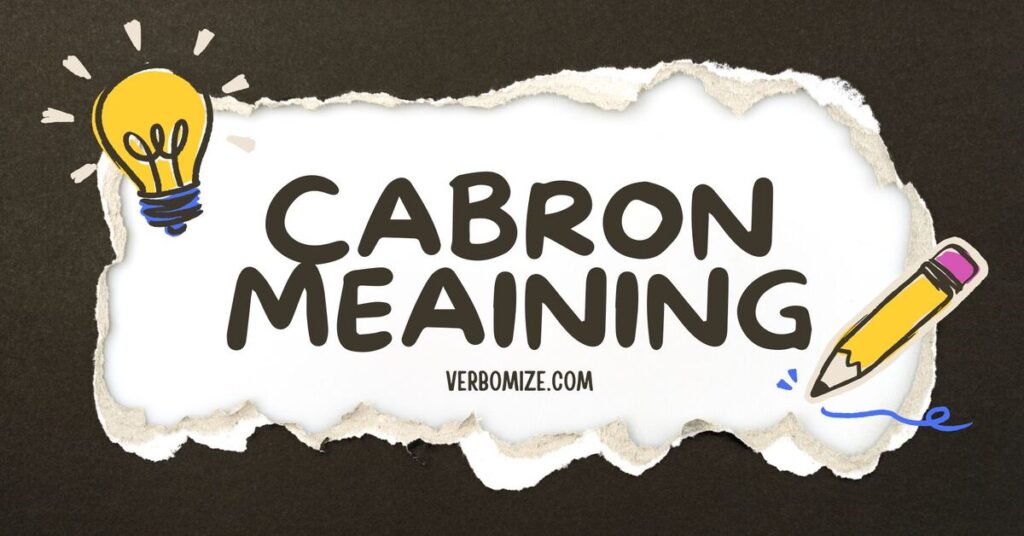Curious about cabron meaning? This Spanish term has a rich and complex history that you might be surprised to learn about. While it’s often used in heated conversations, its true meaning goes beyond what you might first think. Whether you’ve heard it thrown around in movies, music, or everyday life, understanding the real meaning can give you new insight into its cultural significance.
Ready to dive deeper? In this article, we’ll explore the various interpretations and how the word has evolved over time. By the end, you’ll have a much clearer idea of when and why this word is used, and why it might just be more powerful than you imagined.
Introduction to Cabron
Before diving into the complexities of cabron, it’s essential to understand its evolution. While the word originated with a straightforward meaning—referring to a male goat—it has transformed into a term rich in cultural significance across various Spanish-speaking countries. From casual slang to insults and even terms of endearment, cabron has come to symbolize much more than just an animal.
What Does Cabron Mean?
In its most basic sense, cabron is derived from the Spanish word cabra, meaning “goat.” Traditionally, it referred to a male goat, often used metaphorically in literature and casual speech. However, this literal meaning has shifted over time to include several interpretations, ranging from an insult to an affectionate nickname.
Semantic Shift
Cabron has undergone a semantic shift, meaning it has evolved from its literal sense to become a polysemous term. Depending on the tone, context, and relationship between the people using it, cabron can be:
- A harsh insult.
- A friendly term.
- A compliment for someone skilled or impressive.
Understanding these subtle meanings is crucial to using the word correctly. It’s not a one-size-fits-all term, and its meaning can change depending on who’s speaking and how they say it.
Common Uses and Examples
One of the most intriguing aspects of cabron is how its usage differs depending on the social context. Here are some common scenarios where the word might be used:
- In Friendships (as a term of affection): In many parts of Latin America, particularly in Mexico, cabron is used among friends to express camaraderie. For example:
- “¡Eres un cabrón!” (You’re a badass!)
- As an Insult: In some regions, cabron is used as a derogatory term, equivalent to calling someone a jerk or a bastard. For example:
- “¡Qué cabrón eres!” (You’re such a jerk!)
- In Compliments: In certain contexts, particularly when admiring someone’s skill, cabron can be used positively. For example:
- “¡Ese tipo es un cabrón!” (That guy is amazing!)
In these scenarios, cabron is used in ways that either build or break social bonds, demonstrating its complex relationship with contextual meaning.
The Many Faces of Cabron: Different Meanings in Different Contexts
The polysemy of cabron means its interpretation can dramatically shift based on tone, body language, and the social context. Here’s a closer look at the different meanings:
- Insult: This is perhaps the most well-known usage. When said in an angry tone or during a heated argument, it can imply that someone is foolish, a cheat, or unpleasant.
- Example: “¡Eres un cabrón!” (You’re an asshole!)
- Friendly Term: Among friends, cabron can be a playful term of endearment, used similarly to how English speakers might say “dude” or “bro.” It’s not meant to offend but to show a sense of familiarity and camaraderie.
- Example: “¡Qué cabrón! Siempre haces lo que nadie más se atreve.” (You’re such a badass! You do what no one else dares to.)
- Compliment: In certain circles, cabron can be used to show admiration for someone’s intelligence, cunning, or abilities.
- Example: “Este tipo realmente sabe lo que está haciendo.” (This guy truly knows what he’s doing.)
How to Use Cabron in a Sentence
When using cabron, it’s important to recognize that tone and body language are crucial. Depending on how it’s said, it could either be taken as a lighthearted joke or a serious insult.
Sentence Structure and Pragmatics
The meaning can shift depending on how cabron is positioned within the sentence. Consider the following examples:
- “Eres un cabrón.” (You’re a jerk.)
- “¡Qué cabrón eres!” (What a badass you are!)
In the first sentence, it’s a negative insult. In the second, depending on the tone, it could express admiration or playful teasing. Notice how the same word changes with pragmatics, which is the study of how context influences meaning.
The Historical Evolution of Cabron
The history of cabron goes back centuries, and its meaning has changed along with society. Originally, cabron simply referred to a male goat. However, as language evolved, so did its connotations. Here’s a brief historical look:
- Early Usage: In early Spanish, cabron was purely neutral, referring to an animal.
- Medieval Spain: By the Middle Ages, cabron began to be used metaphorically to describe a man whose wife was unfaithful—a cuckold. This meaning still exists in some parts of the Spanish-speaking world.
- Modern Usage: Over time, the term expanded in meaning, now used in a variety of contexts, from insults to terms of endearment, depending on the relationship between the people involved.
Understanding the historical context of cabron can give insight into why it carries so much emotional weight in modern Spanish culture.
Regional Perspectives: Comparing Usage Across Spanish-Speaking Countries
The use of cabron varies significantly across different Spanish-speaking countries, reflecting cultural nuances and societal values. Let’s take a look at how the word is perceived in different regions:
- Mexico: In Mexican Spanish, cabron is commonly used in a friendly, informal context. It can indicate affection or admiration among close friends.
- Spain: In Spain, however, cabron is more likely to be perceived as an insult. It’s often used in arguments or as a way to express anger.
- Argentina: Cabron is less frequently used in Argentina, but when it is, it often implies cunning or shrewdness rather than being an insult.
These regional variations show how cabron has adapted to different linguistic environments and social structures.
Cultural Context: The Sociolinguistic Importance of Cabron
In Spanish-speaking cultures, sociolinguistics plays a key role in shaping the use of words like cabron. The way a word like cabron is used can indicate one’s social standing, the relationship between speakers, and even their emotional state.
For example, when used among friends, cabron can reinforce a sense of closeness and solidarity. In contrast, when used in an argument, it can break down social barriers and create conflict. Understanding cultural context helps to decode the underlying message being communicated.
Gendered Perspectives: Cabron vs. Cabrona
There is an important distinction between cabron and cabrona. While both terms are used to describe individuals in a negative or positive light, the gendered perspective differs.
- Cabron is typically used to describe men, often with admiration or as a mild insult.
- Cabrona, the female counterpart, often carries more negative connotations, especially when used in a derogatory sense. It is less commonly used as a term of endearment.
This gender divide highlights how language mirrors societal attitudes toward gender and the social roles assigned to human beings in different cultures.
Synonyms and Alternatives for Cabron
While cabron is a popular word in Spanish slang, there are many synonyms and alternative phrases that convey similar meanings. Here are some of them:
- For Insults:
- Pendejo: Fool or idiot.
- Gilipollas: Jerk or idiot (used mainly in Spain).
- Bastardo: Bastard.
- For Friendly Terms:
- Güey (Mexico): Dude or bro.
- Amigo (Latin America): Friend.
- Compadre (Mexico): Close friend.
- For Compliments:
- Campeón (Champion).
- Maestro (Master).
- Chido (Cool or awesome, used in Mexico).
These synonyms can be used to adjust the intensity or meaning of the word, depending on the context.
Who Uses Cabron?
Who uses cabron and when? The answer depends largely on social dynamics and age groups. Younger generations are more likely to use it in casual settings, while older individuals may reserve it for moments of anger or frustration. Social class also plays a role; those from less formal backgrounds might use it more frequently in a humorous or affectionate way.
When to Use (and When Not to Use) Cabron
While cabron can be an endearing term among friends, it can also be deeply offensive in certain contexts. Here are some guidelines:
- When to use: Among close friends, in informal settings, and when you have a good relationship with the person.
- When not to use: In formal settings, with strangers, or when you don’t have a strong relationship with the other person. Using cabron in professional settings is highly discouraged.
Why Cabron is More Than Just a Word
Cabron is more than just a word; it serves as a cultural artifact. It encapsulates emotions, social structures, and relationships in Spanish-speaking cultures. Whether used to bond with friends or as an insult, the word carries symbolic weight and is deeply connected to the cultural fabric of the Spanish-speaking world.
FAQs About Cabron
- What’s the difference between cabron and pendejo?
- Cabron is generally stronger and more versatile, whereas pendejo is typically a milder insult.
- Can I use cabron if I’m not a native Spanish speaker?
- Yes, but use it carefully. Ensure you understand the context and the tone of the conversation.
- Can cabron be used in professional settings?
- No, cabron is informal slang and should not be used in formal environments.
Final Thoughts: The Enduring Legacy of Cabron
Cabron is an iconic word in the Spanish language, with deep roots in culture and history. From its humble beginnings as a reference to a male goat, it has evolved into a term with rich cultural nuance, used in a variety of social settings. Understanding cabron helps you understand the social dynamics of Spanish-speaking cultures and enriches your appreciation of the language.
Whether you’re using it to compliment a friend, joke around, or express frustration, remember that the meaning of cabron is shaped by the context, tone, and relationship involved.

Jone Smith is an experienced blogger and content creator behind Verbo Mize. With a passion for storytelling and insightful commentary, Jone brings a wealth of knowledge on diverse topics. His expertise in blogging, combined with a keen eye for detail, makes his work both informative and engaging, offering readers valuable perspectives on a wide range of subjects.







